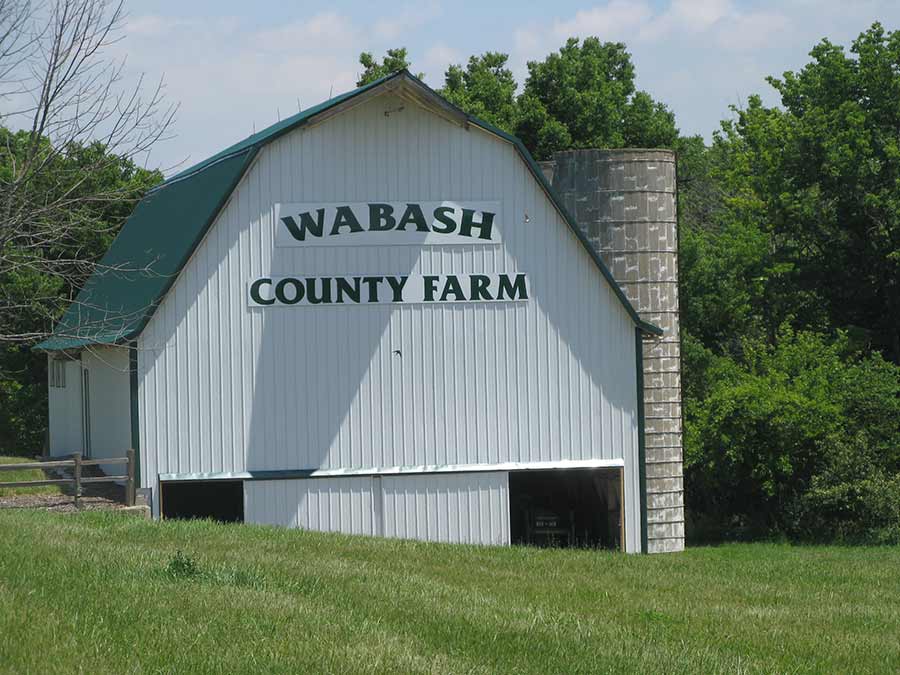Wabash County SWCD utilizes the County Farm as an outdoor learning facility for area educators and also to demonstrate conservation practices.

County Farm

Events include:
- Training days for area farmers, agronomists, NRCS employees.
- Educational station trail for kids
- Corn maze was created by interns and utilized by area groups as a fundraiser.
- Conservation Cropping Systems Initiative Hub Farm (CCSI)
- Cover crop demonstration area.
- Crops grown on the farm using conservation practices.
- Trails are maintained and tours can be arranged.
- Continued work on maintaining the cemetery and searching for more stones.
- (Halloween tours available with Visit Wabash)
- Wooded areas are demonstration sites for invasive species ID and removal. (Keep an eye out for upcoming Workshops)
History of the County Farm
The county of Wabash owns 152 acres on the corner of highway 24 and ALT 24. This property was purchased in 1849 for $3,000 from George E Gordon. The house was built in 1850 for adults who were poor, aged, or infirm and children whose parents were either dead or unable to support them. The first superintendents were paid a wage of $125/year. The goal was to create a self-supporting system where the residents would be involved in all aspects of running the farm. The first recorded burials on property were in 1854 in what became known as the Pauper Cemetery. Grave markers included wooden crosses, field stones, and eventually rose bushes were planted for ladies and trees for the men. It is thought that as many as 677 persons were buried in the cemetery. Formal records were not kept until 1878. One of the most famous burials would have been John Hubbard, who was convicted of murdering the French family. He is the only recorded person to have been hung in Wabash County, 1855. The body was buried for a short time, before doctors who wanted to study the cadaver made plans to steal it. Doctors from Wabash, Huntington, and Fort Wayne were involved in a shoot-out at the cemetery while removing the body. For all who were buried in the Pauper Cemetery a monument was erected in 1944 and is still cared for today.
In 1885 a new orphanage was opened in south Wabash, removing the children from the County Farm. In the early 1900’s the Poor Farm became recognized not only for excellent care for the residents, but also for a small herd of Shorthorn cattle. Hogs, wheat, oats, and hay were also produced on the farm. A gas engine pump furnished water for all purposes with the exception of bathing. The barn that is still remaining was built in 1942. Despite the success of the farm, it was closed in 1974. It was rented out to a childcare facility for a brief time before the home was closed permanently due to needing $15,000 for a new heating system. It was debated what would be done with the property for some time. Some wanted a new jail, industrial park, or new fairgrounds. The Miami Indians of Indiana also requested the property become their tribal headquarters. In the end the tillable acres were rented out and most of the buildings removed, including the house, 1982.
Early 1990’s Wabash County Soil and Water Conservation District takes over the farm to use an outdoor laboratory for local school groups. Not long after this heavy equipment from the landfill were discovered to have been in the cemetery and several graves were collapsed. They were stopped and the damage repaired by leveling the ground. The workers were not aware that the cemetery extended from the main marker and that they were no longer on landfill property. Wabash SWCD took steps to clean up the area and remove the brush. The ponds on the acreage were added in 1995. The barn received a pain job in 2000 by a Girl Scout troop. Since 2008 summer Interns have been hired by Wabash County SWCD for general maintenance and many other projects. Two footbridges were built, trails developed, and many landscaping projects have been completed. By 2012 the farm was selected to be a Conservation Cropping Systems Initiative Training Hub. A state wide approach to educate Indiana Conservation Partnership Staff and producers on the importance of Soil Health. The girl scouts paint had faded and the barn received a new roof and siding in 2013. This was done with the support of the Mel Boyer Family, the Lowell Smith Family, the Wabash County Commissioners and the Wabash County SWCD. 2013 was the same year a Drainage Water Management System was installed, which was donated by Agri Drain Corporation, as well as, the tile for the system that was provided by Fratco Inc. The existing grassed waterway was reshaped and four Water and Sediment Control Basins (WASCOBS) were installed. These practices not only benefit the farm, but can also be used for demonstrations.
In 2020, the SWCD received a Clean Water Indian Grant for $22,300 to restore the 50 wooded acres on the property. Invasive species have degraded the forest. As a result the county farm will also be a demonstration plot for invasive species removal. Several Educational Workshops have been held on the property.
Ground was broken October 4, 2021 for the new Wabash County Jail located on the County Farm land. The facility will be 74,000 square feet with approximately 300 beds. It will replace the current facility at 79 W. Main Street, Wabash. Work on the facility is expected to take 18 months to complete, and has a price tag of roughly $33 million.

